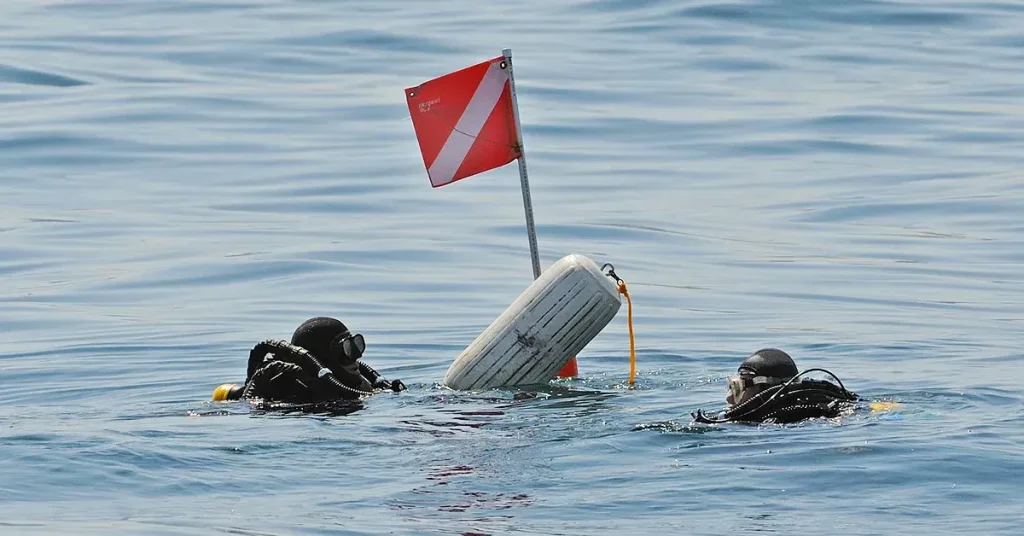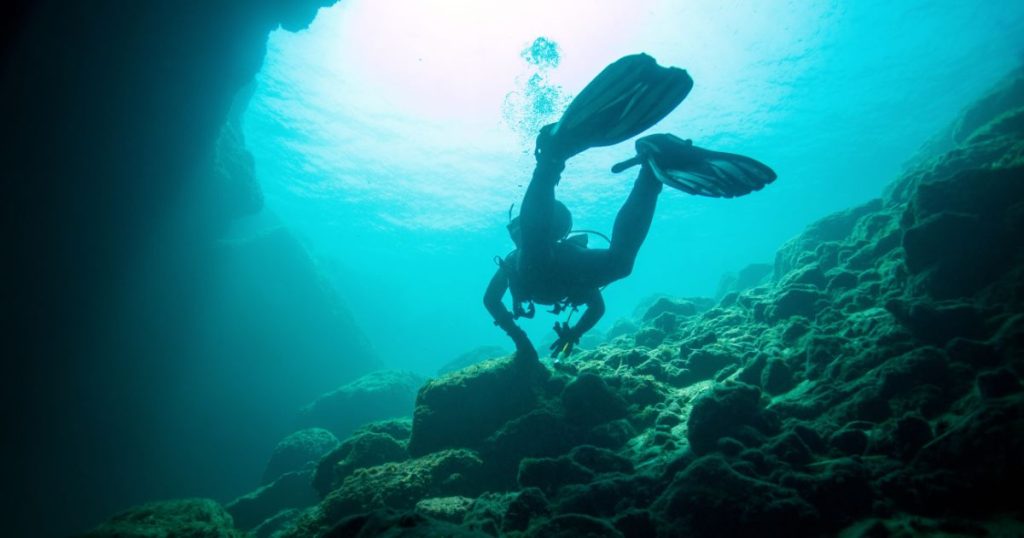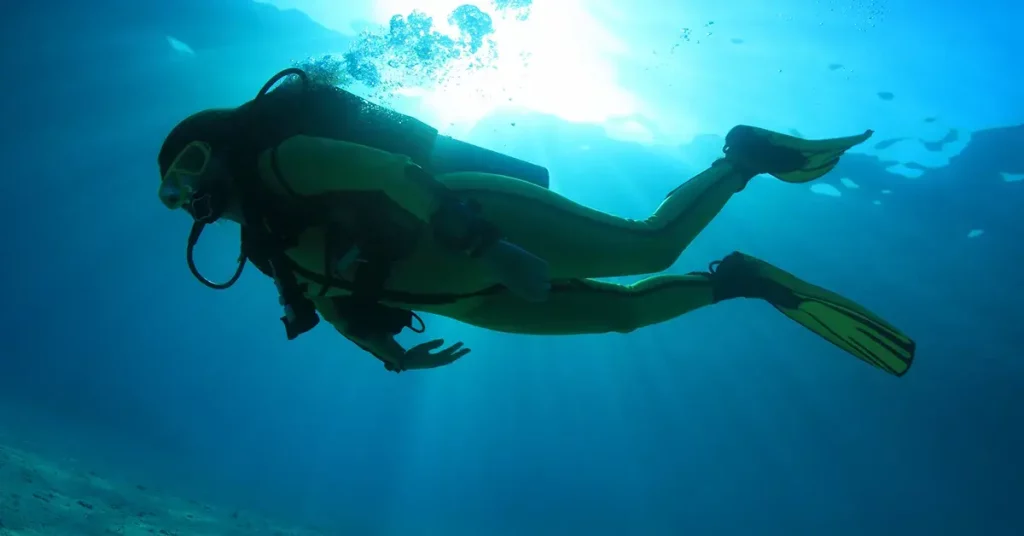Staying safe should be every diver’s top priority. Unfortunately, it’s not only yourself that you need to worry about – passing boats can present a major hazard to any diver near the surface.
A fast-moving boat’s hull or propeller can potentially cause serious bodily harm. Displaying a dive flag signals to passing boats that one or more divers are in the vicinity – and they should slow down and avoid the surrounding area.
You should always display a dive flag when you’re diving. Not only will it keep you visible – but it’s also the law in many countries and most US states.
Quick Answer: 5 Best Dive Flags & Floats
- Best Overall Float: Mares Training Bouy
- Best Gangway Boat: SEAC Sea Mate Inflatable Gangway Boat
- Best Budget Pick: SalviMar Covered Torpedo Buoy
- Best Spearfishing Float: Rob Allen 12L Overblown Hard Float
- Best Dive Flag for Boats: Premium Quality Dive Flag
Why do you need a dive flag
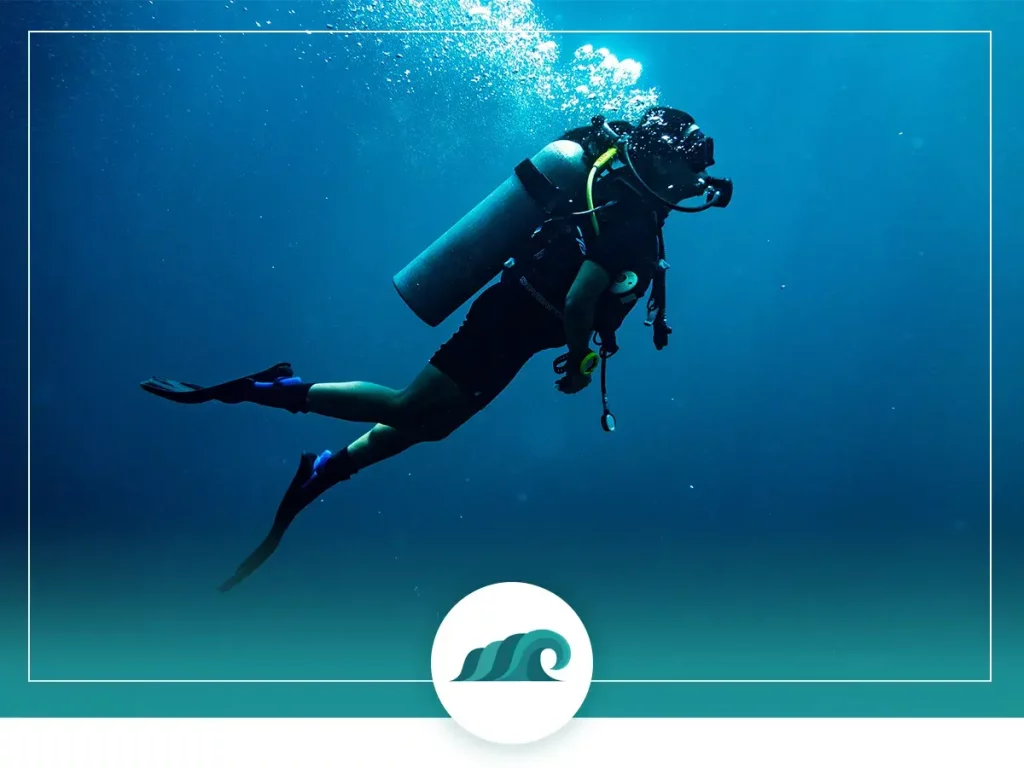
So, why do you need a dive flag?
A dive flag is one of the most critical parts of diver safety. It signals to passing boats that people are diving in the area.
It can also be useful if you run into trouble. In an emergency situation, a dive flag or float would make it easier for a rescue boat to spot your location and provide assistance.
Unfortunately, some boaters act carelessly on the water – and won’t slow down even if you’ve got a dive flag visible. You still need to be aware of your surroundings and keep an eye out for nearby watercraft. Boat licensing is generally not very thorough when it comes to boat/diver interactions – many boaters never even learn what a diver-down flag signifies.
Check out this video for a real-life look at why you need a dive float:
Besides being a good safety protocol, displaying a dive flag is the law in many places. In many states, boats must keep a distance of 300 feet from a diver down flag or buoy. They must also proceed no faster than is necessary to maintain speed. Divers must make reasonable efforts to stay within 300 feet of their flag. In inlets, rivers, and channels the distance is reduced to 100 feet.
There is no federal law that governs flag usage in the US. The rules vary from state to state. Consult your state and local authorities to check on the applicable rules and regulations.
Best Overall Float: Mares Training Buoy
Ideal for freediving, scuba, beach diving, or snorkeling this highly visible float is brightly colored and easy to notice from a distance. Made from heavy-duty Cordura nylon with high frequency welded seams, the exterior of the buoy is highly durable and easily visible.
The inner-tube style design allows you to store a good amount of gear in the middle, such as weights, drinking water, and camera equipment. The outer nylon material has a large square zipper opening – giving access to the inner storage area. One user reports loading the float up with a 25-pound plate plus water and camera gear regularly without any issues.
Four D-rings surround the buoy for attaching line, as well as four durable handles for holding onto while you take a break. The bottom of the float has 12 drainage holes incorporated to allow any pooled water to drain out.
A flag mount is built into the buoy, but Mares sells the dive flag separately.
Key Features
- Versatile buoy works well for a variety of applications
- Oral inflator with overpressure valve
- Useful for storing extra gear while freediving or scuba diving
- Not ideal for spearfishing
- Tough exterior, four external handles for preparing pre-immersione
- Four internal external D-Ring, ample space for storing the Sagola during transport
- Zipped outer pocket, mouth inflation device and over pressure valve
Prices pulled from the Amazon Product Advertising API on:
Product prices and availability are accurate as of the date/time indicated and are subject to change. Any price and availability information displayed on [relevant Amazon Site(s), as applicable] at the time of purchase will apply to the purchase of this product.
Best Gangway Boat: SEAC Sea Mate Inflatable Gangway Boat
This handy, brightly colored raft is designed to clearly display the diver down flag, as well as store extra gear for spearfishing, scuba or freediving. The design is streamlined and hydrodynamic, which makes towing or swimming with it through the water a breeze.
Made of tough 420 D polyester, the outer shell is thick enough to withstand hard use. There are three sturdy inflatable bladders inside the raft – so if one bladder gets pierced, the raft would stay floating on the surface.
Highly useful for spearfishing (particularly for shore dives), this little raft allows you to strap in extra spearguns, spears, masks, and other important gear. You can also use it to keep a few fish secure while you continue diving.
Scuba divers also find this design to be useful – it can hold an extra tank of air and is a good platform to rest on.
Key Features
- The included flag may not be regulation size in your area
- Hydrodynamic design easy to transport in the water
- 3 internal bladders keep the raft afloat in case one is punctured
- Made of 420 D polyester with black bottom and orange surface for high visibility
- Roomy forepeak pocket
- Elastic side straps with Velcro safety device to attach spear guns and spears
View Pricing On:
Best Budget Pick: SalviMar Covered Torpedo Buoy
A quality dive float doesn’t need to cost an arm and a leg. This torpedo style float is perfect for all types of diving, snorkeling, and spearfishing. The brightly colored orange exterior is highly visible as well as rugged. The outer cover is made from puncture-resistant nylon fabric which keeps the inner air bladder protected.
Two dive flags come included, the US style red and white flag, and the international blue and white Alpha flag. The flags are a little on the small side (8” x 7.25”), so you may need to get a larger flag if your local regulations require it.
Some people report the float not staying upright in choppier weather, but this is easily solved by adding a small weight inside the bottom of the float cover.
Multiple D-rings are attached all around the float, enabling you to attach lines or gear to the float. A long length of orange nylon line is also included.
Key Features
- Brightly colored orange float is highly visible
- Comes with 2 dive flags – US and international
- Useful for all types of diving
- Measures 31” x 10”
- Torpedo buoy
- Fabric cover and rings
- Comes with 2 flags
- Country Of Origin : China
Prices pulled from the Amazon Product Advertising API on:
Product prices and availability are accurate as of the date/time indicated and are subject to change. Any price and availability information displayed on [relevant Amazon Site(s), as applicable] at the time of purchase will apply to the purchase of this product.
Best Spearfishing Float: Rob Allen 12L Overblown Hard Float
Tough, rugged, and built like a tank, this spearfishing float is built to withstand hard use in the saltwater environment. The outer shell is constructed of hard polyethylene plastic, while the inner portion is filled with high-quality polyurethane foam to increase density and buoyancy.
It’s ‘overblown’ construction means that it’s filled with more foam than similar models – which helps keep the float upright and displaying the dive flag. The torpedo shape also makes it streamlined and able to cut through surface chop well. A keel ballast weight is included to help keep the float upright.
Two clips are included on the front and back of the float for rigging lines.
Due to its solid construction, it will take up more space in your kit than an inflatable float would. The upside is it will never get punctured or develop a leak.
Some versions of this float come with a flag, while others do not. You may need to purchase a dive flag separately.
Key Features
- Extremely rugged polyethylene construction – built to last
- Measures 24” x 7.5” x 4”
- Overblown foam design gives it extra density – which makes it tougher for fish to drag
- Tough Polyethylene Outer Shell and a hollow core
- Can cut through the surface chop extremely well
- Comes with clips and strap
- Dive Flag is optional
Prices pulled from the Amazon Product Advertising API on:
Product prices and availability are accurate as of the date/time indicated and are subject to change. Any price and availability information displayed on [relevant Amazon Site(s), as applicable] at the time of purchase will apply to the purchase of this product.
Best Dive Flag for Boats: Premium Quality Dive Flag
If you’re looking for a dive flag to display from your boat or attach to a float, you can’t go wrong with this durable nylon flag. It’s made of thick nylon material, with double stitched reinforced vinyl corners. The grommets are solid brass so will not rust.
A 3-piece collapsible stiffening rod comes included, which keeps the flag fully displayed in all-weather conditions. The stiffening rod works like a tent pole – you simply unfold it, clip the pieces together, and then insert the rod through the Velcro pocket and sleeves on the back of the flag.
You can easily attach the flag to a boat, Jet Ski, raft or float using zip ties or carabineers.
The dimensions are 20” x 24”, which complies with most state laws (including Florida).
Key Features
- Measures 20” x 24”
- Comes with collapsible stiffening rod which is required in Florida
- Excellent quality, especially considering the price
- MADE OF DURABLE NYLON. BRASS GROMMETS - Corners are reinforced with vinyl for durability. Bright red and white colors for a clear warning to boaters
- MEETS STATE REGULATIONS - 20 by 24 with a stiffening pole to comply with state laws. Most states (including Florida) require these specifications.
- COLLAPSIBLE STIFFENING POLE INCLUDED - Keeps flag fully displayed in still conditions. Pole fits through sleeve and into velcro pouch to keep it secure. Folds into 3 sections like a tent pole for easy storage.
- EASY TO USE MULTIPURPOSE DIVE FLAG - Quick and simple assembly. Use on a boat, off the beach, or attached to a float. Includes 2 Zip Ties.
- 100% MONEY BACK GUARANTEE - All flags are backed by 100% guarantee. If youre not satisfied we will replace it or refund you.
Prices pulled from the Amazon Product Advertising API on:
Product prices and availability are accurate as of the date/time indicated and are subject to change. Any price and availability information displayed on [relevant Amazon Site(s), as applicable] at the time of purchase will apply to the purchase of this product.
Dive Flag Types
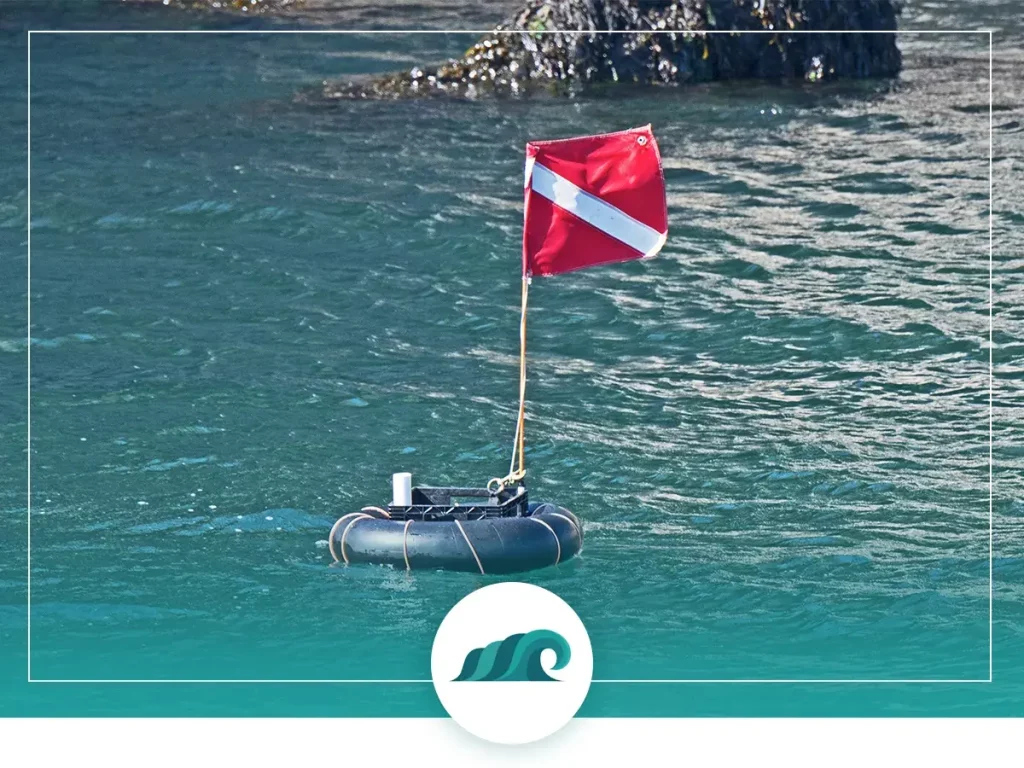
There are two main dive flags used to indicate that divers are operating in the area.
In North America, the flag used is red with a solid white stripe running diagonally across it. It’s commonly known as the ‘Diver Down’ or ‘Diver Below’ flag. Over the years this flag has become a widely recognized symbol for diving – you’ll often find it displayed outside dive shops or other businesses catering to divers.
The story of how this flag became so widely used is rather interesting.
In the 1950’s inventor and entrepreneur Denzel James ‘Doc’ Dockery was looking for a way to alert boaters to keep a safe distance from where he was diving. Having been in the navy, he was familiar with the Navy’s “Bravo flag” used to signify danger. He asked his wife to sew a similar flag, but changed the white strip from vertical to horizontal. The only problem was it happened to be the same flag as Austria’s!
He eventually settled on a diagonal white stripe and started selling and promoting his design. Shortly afterward, his home state of Michigan officially recognized the flag, followed by the federal government and almost every other US state.
The other dive flag you should know about is the internationally recognized Alfa/Alpha flag. This flag originated as the international maritime signal flag Alpha (signifying the letter ‘A’). It’s blue and white with a triangular cutout in the blue section. While not typically used in US waters, this flag is used regularly in Europe and British Commonwealth countries. A boat displaying this flag is indicating that divers are in the water surrounding it and its movement is restricted.
If you’re in doubt about which flag to display, flying both dive flags is a safe bet.
Dive Floats
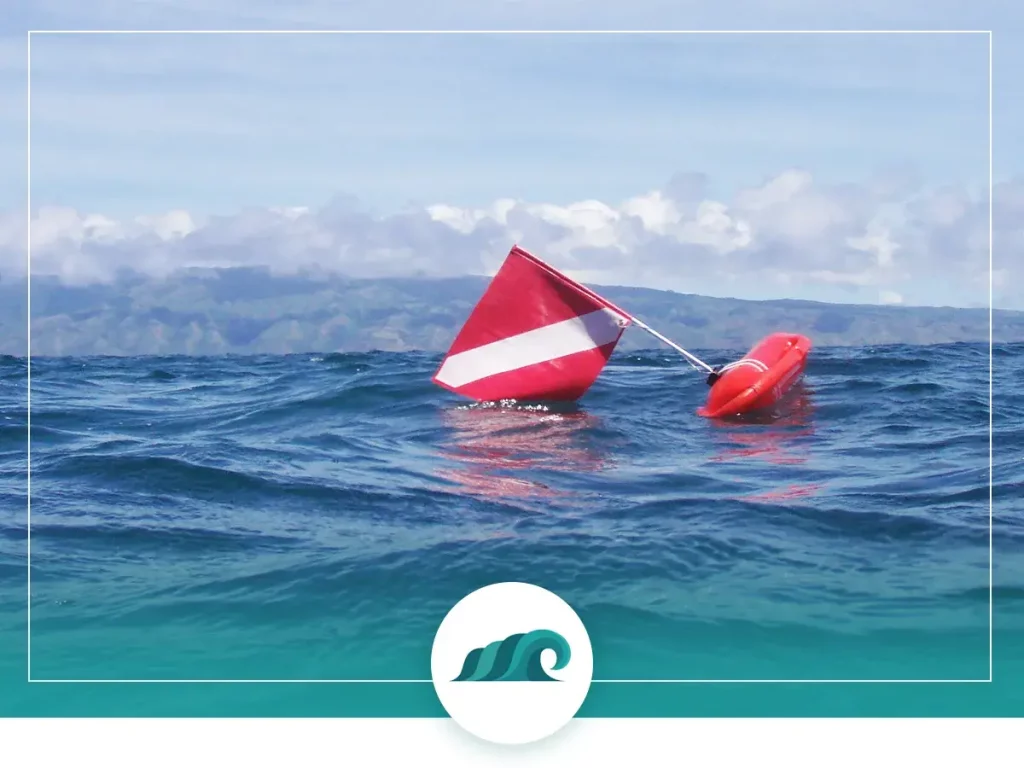
Dive floats are a convenient way to display a diver down flag, especially if you’re shore diving, spearfishing or freediving without a boat. It’s extra important to have a dive flag visible when you’re diving without a boat – otherwise passing boats won’t know anyone is in the water.
In general, you want a float that stays upright, is highly visible from a distance, and can be seen above any waves or chop. Many floats have a ballast system built into the bottom. This allows you to add weight to the bottom of the float for extra stability.
When spearfishing, a float serves multiple purposes:
- It signals to nearby boats that a diver is in the water.
- It can be rigged to your speargun butt with a line. This allows you to shoot a fish, release your speargun and swim to the surface to reel in the fish.
- Larger floats can be used as storage areas for extra gear, spearguns, pole spears, and drinking water. You can also store your catch on one of these floats – keeping any curious sharks from stealing your dinner!
If you’re looking for a spearfishing float, look for one with a streamlined hydrodynamic design. This will allow you to move through the water without too much drag.
If you’re using a float for scuba diving, a larger float will allow you to store extra gear and equipment, as well as serving as a platform to rest at the surface.
Scuba divers will often use a smaller dive float called a surface marker buoy which enabled their dive boat to locate them in low visibility conditions.
Maintenance
Be sure to rinse off your flag and float with fresh water after every use. Store them in a dry place (such as a dive bag) away from direct sunlight.
Dive flags may sustain sun damage over time causing the red color to fade away. If your flag is starting to fade, get a new one. They don’t cost much and you want the flag to be as visible as possible.
If you secure the float with a line, make sure to check it frequently for any worn or frayed spots and replace it if necessary.
FAQ’s
What’s the best way to tie a dive flag to your body?
Attaching a dive flag to your body is generally not a good idea. If you need to attach a line from yourself to a dive float, use a lanyard with a quick-release buckle. That way if the float were to get snagged by a passing boat you could release the line and prevent getting dragged upwards.
When spearfishing, many spearos prefer to attach a line from their float to the butt or handle of their speargun. That way, if you happen to run into trouble, you can release your speargun and swim unencumbered to the surface.
What does a diver down flag look like?
The diver down flag is a red square or rectangle with a diagonal white stripe across it. The white stripe should be 25 percent of the height of the flag.
What are the two types of diver down flags?
The dive flag used predominantly in North America is a red square or rectangle with a white diagonal stripe through it. This flag is called the ‘diver-down’ flag. The other dive flag used internationally is blue and white and known as the ‘Alpha’ or ‘Alfa’ flag.
Boats should maintain what distance from a diver down flag?
The rules vary in different locations. But in general, boats should maintain a distance of 300 feet from dive flags in open water, and 100 feet in inlets, rivers, and channels.
What are the dive flag regulations in Florida?
Florida regulations require dive flags to be either square or rectangle, and have a wire or flag stiffener to keep the flag upright.
Flags on buoys must have a minimum size of 12” x 12”. Flags flown from boats must be a minimum size of 20” x 24”, and must be displayed from the highest part of the boat to ensure visibility from all sides.
A dive flag must be displayed at all times while divers or snorkelers are in the water (including beach entry diving), and must be lowered when there are no divers or snorkelers in the water. The distances required for boats and divers are the same as written above.
A boater “Buzzing” a dive flag is considered a first-degree misdemeanor and is punishable by up to a $1000 fine and/or six months in jail.

